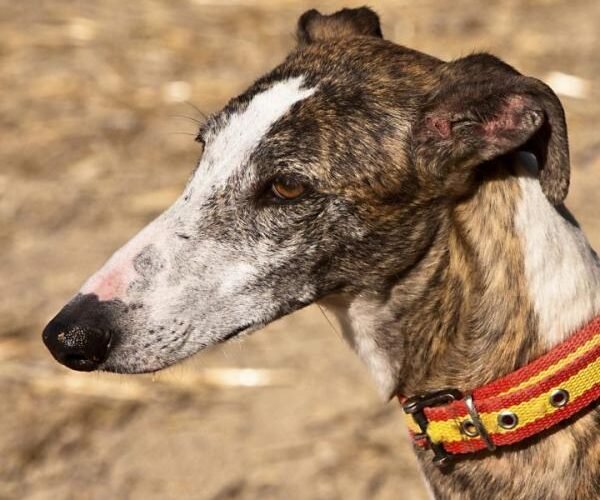The Spanish greyhound is an extraordinary dog. They are friendly, clean, obedient, docile and very affectionate with children. Perhaps their main downfall is their need to run a lot. This virtue turns against them because they are used by individuals who try to gain profit at their expense. They are undoubtedly the most abused dog in the Iberian Peninsula.
They are relatively easy to adopt in a kennel, since their cruel first owners do not hesitate to get rid of them if they do not run enough for them.
In this article we encourage you to rescue these magnificent dogs from kennels or animal shelters. Furthermore, we will explain how to care for a Spanish greyhound, so you decide to adopt and enjoy this extraordinary pet.
How much exercise does a Spanish Greyhound need?
The Spanish greyhound is a large dog, although very light in weight. They have a very muscular body, at the same time very stylized. Their legs are long and thin, but very efficient. This allows them to develop tremendous speeds that exceed 60 km/hour. They are considered the second fastest dog on the planet , after the English Greyhound.
If we want to exercise with a Spanish greyhound, particularly if they are adopted, it is important not to leave them off leash in open places. It is very common for the greyhound to run and not return to your call. Look for a dog park or controlled area for them.
Although they may seem to need high doses of exercise, the truth is they are very quiet dogs that does not require more than 3 walks daily, like any other dog. Younger specimens may develop more active behavior but tend to decrease this energy as they mature.
The collar should be specific to this breed, since their head is almost the same diameter as their neck. A normal collar would easily slip off the neck of the Spanish greyhound. The appropriate tool for this breed is a type called Martingale, which is a double ring anti-leak collar (not to be confused with the barrel collar or half-barrel metal or barbed). However, it is always advisable to use an anti-escape safety harness – much more comfortable for the dog.

How to care for a Spanish Greyhound’s coat
The coat of the Spanish greyhound usually consists of a very short, dense and smooth fine hair. Their coat can practically any color, but the most popular is dark and brindled.
Given the characteristics of their coat, a brief brushing every 2 or 3 days is enough to keep them free of dead hair and dirt. Choose a dog brush for short hair so as not to damage their dermis. The most popular ones are usually rubber.
Regarding the frequency of bathing, it should be noted that since they are fat free, their scent is not as potent as other breeds. This means that this race needs many fewer baths than others. It is advisable to do a bath when they are really dirty .

Among the care of the Spanish greyhound will also be very important to note that they can suffer from extreme temperatures.For that reason, it is very important that we highlight some aspects to take into account during summer and winter:
– Summer
The Spanish greyhound is prone to heat stroke. For this reason, ensure that you never run out of water. You can help cool them off with a spray bottle of water or a small pool in your garden. During the summer you must take care and avoid walks in the hottest hours. Do not force them to exercise and during visits to the beach we must not forget an umbrella to protect from the effect of the sun.
– Winter
In winter you will proceed with the opposite. You will take care of your greyhound exposing as little as possible to the icy winter elements, and during the winter season have a warm coat for them. They are very cool breeds that suffer greatly from falling temperatures. You should also protect them from the rain with an appropriate raincoat.

More essential care
We must provide thick and comfy beds, so that their bones do not rub against any hard surfaces that can cause bone injury. It is ideal that you add a blanket or comforter that the dog can move to your liking. Greyhounds love to sleep in soft, padded places.
We must also know that the Spanish greyhound is undoubtedly a very sleepy dog. They usually rest up to 18 hours a day. Perhaps for this reason, the Spanish greyhound is a large dog that can live perfectly in a flat, since their calm and good nature makes them comfortable in a smaller space.

Veterinary care and specific diseases
The Spanish greyhound is a very healthy breed. Their specific care is basically about adapting to the elements, because of their peculiar anatomy. Their life expectancy ranges from 10 to 14 years.
Unlike other breeds of large dogs, the greyhound is not susceptible to dysplasia, a common ailment. Yet they can develop some health problems that you need to know in order to prevent them in time. Fractures and injuries are very common in dogs that have previously competed in racing.
Feed should be based on dry feed of the highest quality. They should not get fat, since their bones are not formed to support being overweight. Always use the container of dry food that you provide them to know the exact amount of food they need.
A particular detail to keep in mind is that the trough should be placed at half height. This is to prevent them crouching too much when eating and drinking. In this way we will avoid them injuring the cervicals and suffering from stomach twisting.
The rest of their necessary veterinary care will be the same for any dog, regardless of the breed. Take them to the vet every 6 months and we make sure to comply with their vaccination schedule strictly. We must also deworm them externally once a month and internally once every three months. You can discuss all these details with your vet of choice.
Do not forget to put a chip on your best friend. Greyhounds can get lost easily because when they start to run they do not stop until they feel safe or lost! This should be one of your priorities whilst caring for a spanish greyhound.

Social needs of greyhounds
The Spanish greyhound hardly barks. They are very friendly dogs that enjoy the company of people and other pets. They are very patient with the children. Being a sensitive dog and with great need for affection, the greyhound can suffer from separation anxiety. This problem should be addressed as soon as possible and with the help of a specialist if necessary.
These dogs are very sociable and their temperament is free of any territorial instinct. This makes them very compatible with other pets (cats and small dogs), although it is risky to put them together with rabbits.
It would be ideal for our greyhound to enjoy the company of another member of their species, particularly if we leave them alone a few hours a day. In general, greyhounds are accustomed to live with other greyhounds so it is highly recommended to adopt a pair of companions instead of one.

Source: animalwised.com



